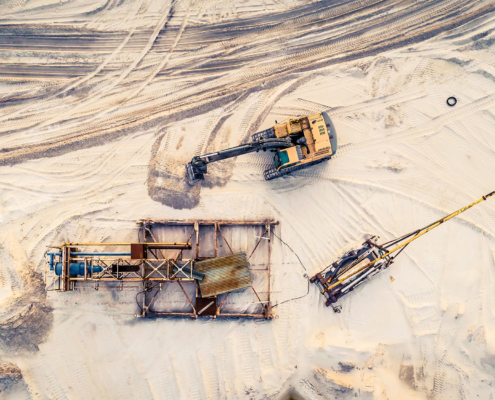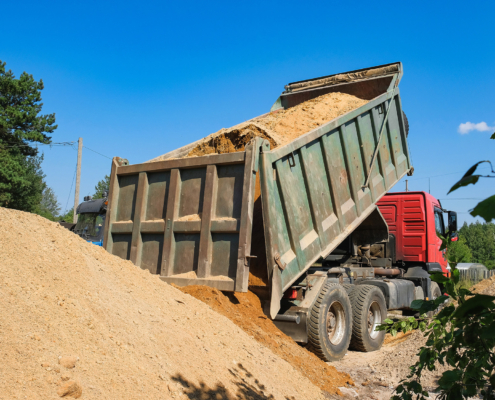 https://pontotocsandandstone.com/wp-content/uploads/2025/09/Frac-Sand-Market-Trends-and-Forecasts.jpg
1250
2000
AbstraktMarketing
/wp-content/uploads/2021/08/Pontotoc-White-Logo.png
AbstraktMarketing2025-09-05 20:26:142025-12-11 16:20:13Navigating Growing Demand: Frac Sand Market Trends and Forecasts
https://pontotocsandandstone.com/wp-content/uploads/2025/09/Frac-Sand-Market-Trends-and-Forecasts.jpg
1250
2000
AbstraktMarketing
/wp-content/uploads/2021/08/Pontotoc-White-Logo.png
AbstraktMarketing2025-09-05 20:26:142025-12-11 16:20:13Navigating Growing Demand: Frac Sand Market Trends and ForecastsUnderstanding Frac Sand Storage Methods
Oil and gas operations can be complex, especially when it comes to storage. Frac sand storage is a critical part of the process, ensuring the sand used in fracing operations remains safe and secure throughout its life cycle. In this article, we’ll discuss why frac sand storage is important and go over key safety considerations for storing frac sand as well as some helpful methods for the process. Let’s get started!
Why Is Frac Sand Storage Important?
Frac sand is a critical part of the oil and gas extraction process. The sand helps create fractures in the rock formations, allowing oil and gas to flow more freely. For this reason, frac sand needs to be stored correctly, as any contamination or degradation of the sand could reduce its effectiveness.
Frac sand storage has become essential due to the significant increase in fracing over recent years. As more oil and gas companies begin to use fracing processes, the demand for sand storage has increased drastically. This means that storage must be done properly to ensure a successful operation.
Safety Considerations for Sand Storage
When it comes to the safe storage of frac sand, several key considerations must be taken into account.
- Proper containment systems should be used to prevent leakage or contamination during transport or storage.
- Employees handling frac sand must wear protective gear (dust masks and gloves) at all times.
- Ensure proper ventilation to maintain low dust levels and ensure employee health and safety.
- Regular maintenance schedules should be maintained for storage tanks, pipes, valves, etc., to prevent dust accumulation and clogging.
Tank Sand Storage Benefits
To ensure the uninterrupted supply and efficient handling of frac sand, many companies are turning to tank sand storage.
Protection From the Elements
Traditional open storage methods leave frac sand vulnerable to adverse weather conditions, including rain, wind, and extreme temperatures. Such exposure can result in the degradation of sand quality, leading to inefficiencies during the fracking process. In contrast, tank storage provides a controlled environment that shields the sand from moisture, dust, and temperature variations, ensuring the quality and integrity of the material.
Enhanced Efficiency
With proper organization and labeling, tanks allow for efficient inventory management, making it easier to track and access specific quantities of sand as needed. Additionally, the ability to store frac sand in close proximity to sites reduces transportation time and costs. This streamlined process helps operators maximize resource use, minimize downtime, and improve overall operational efficiency.
Reduced Contamination Risks
When stored in tanks, frac sand is shielded from potential sources of contamination, such as debris, animals, and unauthorized access. Tank storage also minimizes the risk of cross-contamination between different sand types, ensuring the consistency and quality of the material used in each fracking operation.
Long-Term Cost Savings
While the initial investment in tank frac sand storage may seem substantial, it often leads to long-term cost savings. The protection provided by tanks extends the shelf life of the frac sand, reducing the need for frequent replacements. By preserving the quality and integrity of the sand, operators can avoid costly disruptions and downtime caused by sand-related issues.
Proper frac sand storage is an important method to saving money, but your application can also save big when it comes to transportation. Learn more today.
Frac Sand Silos
Frac sand silos are an excellent solution for applications looking for frac sand storage. They provide an economical, space-efficient, and safe way to store large amounts of sand at the well site.
Conveyor Systems
Frac sand conveyor systems are designed to move large volumes of sand from one place to another. They employ an auger or screw-type device that can move large amounts of sand quickly and efficiently, with minimal effort. Some conveyor systems can be automated to increase productivity, while others can be loaded and unloaded manually on a job site. The benefits of using conveyor systems include increased efficiency, cost savings, reduced manual labor, and improved safety.
Pneumatic Systems
Pneumatic frac sand systems use compressed air to transport the material from one place to another. These systems are generally less expensive than their conveyor counterparts, but they might require extra labor for loading and unloading. These transport methods can be more complex since multiple components must be installed and maintained correctly for proper operation.
Pneumatic systems also offer benefits such as faster transportation speeds due to lower friction between moving particles and the air molecules in the tube they are traveling through. Pneumatic systems are also much quieter than other transportation methods for frac sand storage.
Frac Sand Storage Maintenance Tips
Neglecting maintenance can lead to equipment failure, decreased productivity, and increased costs. Below, we’ll explore some important maintenance tips for frac sand storage systems that can help you optimize performance and extend the lifespan of your equipment.
- Regular inspection and cleaning: Regular inspections of your frac sand storage system are vital to identify any signs of wear, damage, or blockages. Inspect hoppers, conveyors, and transfer points for signs of material buildup or clogging. Clean any accumulated debris or dust to prevent system inefficiencies.
- Lubrication and belt maintenance: Proper lubrication is essential for the smooth operation of conveyor belts and other moving components within the storage system. Follow the manufacturer’s recommendations for lubrication intervals and use the appropriate lubricants. Regularly inspect belts for signs of wear, tears, or misalignment. Adjust tension and replace worn-out belts promptly to prevent costly repairs or unplanned downtime.
- Dust collection and ventilation: Dust control is a significant concern in frac sand storage systems due to the fine particles generated during handling and transfer. Implementing an effective dust collection and ventilation system is crucial for maintaining air quality and preventing dust accumulation in equipment and surrounding areas. Regularly inspect and maintain dust collection systems, including filters, ductwork, and fans, to ensure they function optimally.
- Structural integrity: Inspect the structural components of your frac sand storage system, such as bins, silos, and support structures, for any signs of corrosion, cracks, or degradation. Address any issues promptly to prevent potential failures resulting in safety hazards and material loss.
- Electrical and control systems: Proper functioning of electrical and control systems is essential for the overall operation of frac sand storage systems. Regularly inspect electrical components, such as motors, switches, and wiring, for signs of damage or wear. Test control systems to ensure accurate monitoring and control of material flow.
Partner With Pontotoc Sand & Stone for the Best Frac Sand Handling Practices In the Industry
Ensuring your frac sand is stored securely and safely is key to keeping production running smoothly. With tank or silo storage methods both offering a variety of benefits, it’s important to understand which one suits your requirements the best. Contact Pontotoc Sand & Stone today for the best frac sand storage applications.
Related Postings
 https://pontotocsandandstone.com/wp-content/uploads/2025/09/Frac-Sand-Market-Trends-and-Forecasts.jpg
1250
2000
AbstraktMarketing
/wp-content/uploads/2021/08/Pontotoc-White-Logo.png
AbstraktMarketing2025-09-05 20:26:142025-12-11 16:20:13Navigating Growing Demand: Frac Sand Market Trends and Forecasts
https://pontotocsandandstone.com/wp-content/uploads/2025/09/Frac-Sand-Market-Trends-and-Forecasts.jpg
1250
2000
AbstraktMarketing
/wp-content/uploads/2021/08/Pontotoc-White-Logo.png
AbstraktMarketing2025-09-05 20:26:142025-12-11 16:20:13Navigating Growing Demand: Frac Sand Market Trends and Forecasts https://pontotocsandandstone.com/wp-content/uploads/2025/08/How-Supply-Chain-Disruptions-Impact-Frac-Sand-Availability-and-Pricing.jpg
1250
2000
AbstraktMarketing
/wp-content/uploads/2021/08/Pontotoc-White-Logo.png
AbstraktMarketing2025-08-21 20:34:102025-12-11 16:20:15How Supply Chain Disruptions Impact Frac Sand Pricing and Availability
https://pontotocsandandstone.com/wp-content/uploads/2025/08/How-Supply-Chain-Disruptions-Impact-Frac-Sand-Availability-and-Pricing.jpg
1250
2000
AbstraktMarketing
/wp-content/uploads/2021/08/Pontotoc-White-Logo.png
AbstraktMarketing2025-08-21 20:34:102025-12-11 16:20:15How Supply Chain Disruptions Impact Frac Sand Pricing and Availability https://pontotocsandandstone.com/wp-content/uploads/2025/08/large-quary-for-frac-sand-mining.jpg
1250
2000
AbstraktMarketing
/wp-content/uploads/2021/08/Pontotoc-White-Logo.png
AbstraktMarketing2025-08-14 19:56:332025-12-11 16:20:15Understanding the Health and Environmental Impacts of Frac Sand Mining
https://pontotocsandandstone.com/wp-content/uploads/2025/08/large-quary-for-frac-sand-mining.jpg
1250
2000
AbstraktMarketing
/wp-content/uploads/2021/08/Pontotoc-White-Logo.png
AbstraktMarketing2025-08-14 19:56:332025-12-11 16:20:15Understanding the Health and Environmental Impacts of Frac Sand Mining